#Norma Taurog
Text
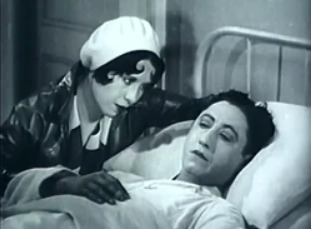
Marjorie Kane-Benny Rubin "Sunny skies" 1930, de Norman Taurog.
3 notes
·
View notes
Text
ZIEGFELD FOLLIES
April 8, 1946
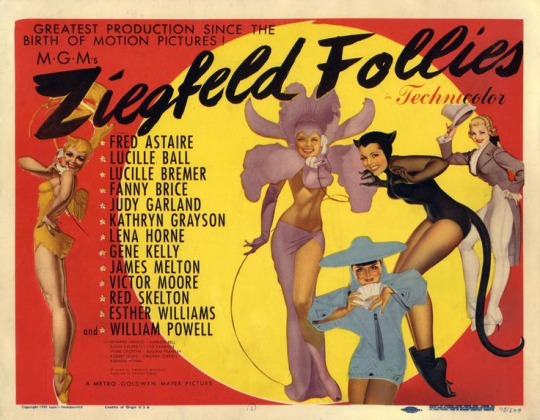
Directors: Lemuel Ayers, Roy Del Ruth. Vincente Minnelli, George Sidney,
Norman Taurog, Charles Walters. Robert Lewis
Producer: Arthur Freed for Metro Goldwyn Mayer
The shooting schedule ran between April 10 and August 18, 1944, with retakes plus additional segments filmed on December 22, 1944 and then between January 25 and February 6, 1945. The film was first proposed in 1939.
Synopsis ~ We meet a grayed, immaculately garbed Florenz Ziegfeld, Jr. in Paradise (his diary entry reads "Another heavenly day"), where he looks down upon the world and muses over the sort of show he'd be putting on were he still alive.
PRINCIPAL CAST

Lucille Ball ('Here's to the Ladies') is appearing in her 64th film since coming to Hollywood in 1933.
Fred Astaire ('Here's to the Ladies' / Raffles in 'This Heart of Mine' / Tai Long in 'Limehouse Blues’ / Gentleman in 'The Babbit and the Bromide') also appeared with Lucille Ball in Roberta (1935), Top Hat (1935), and Follow the Fleet (1936). His name was mentioned twice on “I Love Lucy.”
Lucille Bremer (Princess in 'This Heart of Mine' / Moy Ling in 'Limehouse Blues')
Fanny Brice (Norma Edelman in 'A Sweepstakes Ticket') appeared in the original stage version of many editions of The Ziegfeld Follies on Broadway.
Judy Garland (The Star in 'A Great Lady Has An Interview') also starred with Lucille Ball in Thousands Cheer (1943).
Kathryn Grayson (Kathryn Grayson in 'Beauty') also starred with Lucille Ball in Thousands Cheer (1943).
Lena Horne (Lena Horne in 'Love') also starred with Lucille Ball in Thousands Cheer (1943).
Gene Kelly (Gentleman in 'The Babbit and the Bromide') also starred with Lucille Ball in Thousands Cheer (1943), Du Barry Was A Lady (1943), and A Guide for the Married Man (1967). He made an appearance on the Lucille Ball special “Lucy Moves to NBC” (1980).
James Melton (Alfredo in 'La Traviata')
Victor Moore (Lawyer's Client in 'Pay the Two Dollars')
Red Skelton (J. Newton Numbskull in 'When Television Comes') also starred with Lucille Ball in Having Wonderful Time (1938), Thousands Cheer (1943), Du Barry Was A Lady (1943), and The Fuller Brush Girl (1950). On TV he appeared on “The Lucy-Desi Comedy Hour” in “Lucy Goes To Alaska” (1958). Ball and Skelton appeared in numerous TV specials together.
Esther Williams (Esther Williams in 'A Water Ballet') also appeared with Lucille Ball in Easy To Wed (1946).
William Powell (Florenz Ziegfeld Jr.) also played the same character in The Great Ziegfeld (1936).
Edward Arnold (Lawyer in 'Pay the Two Dollars') appeared with Lucille Ball in Roman Scandals (1933) and Ellis in Freedomland (1952).
Marion Bell (Violetta in 'La Traviata')
Cyd Charisse (Ballerina in 'Beauty') also starred with Lucille Ball in Thousands Cheer (1943).
Hume Cronyn (Monty in 'A Sweepstakes Ticket') was honored by The Kennedy Center in 1986, at the same ceremony as Lucille Ball.
William Frawley (Martin in 'A Sweepstakes Ticket') played the role of Fred Mertz on “I Love Lucy” and “The Lucy-Desi Comedy Hour”. He also appeared on “The Lucy Show,” his final screen appearance.
Robert Lewis (Chinese Gentleman in 'Limehouse Blues' / Telephone Voice in 'Number Please')
Virginia O'Brien (Virginia O'Brien in 'Here's to the Ladies') also starred with Lucille Ball in Thousands Cheer (1943), Du Barry Was A Lady (1943), and Meet The People (1944).
Keenan Wynn (Caller in 'Number Please') appeared with Lucille Ball in Easy To Wed (1946), Without Love (1945), and The Long, Long Trailer (1954).
SUPPORTING CAST
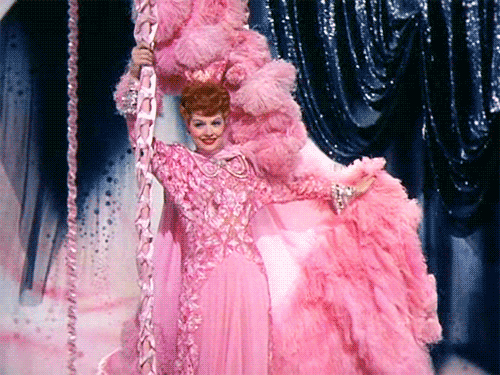
Ziegfeld Girls
Karin Booth
Lucille Casey
Aina Constant
Elizabeth Dailey
Frances Donelan
Natalie Draper
Karen X. Gaylord
Aileen Haley
Carol Haney
Shirlee Howard
Margaret Laurence
Helen O'Hara
Noreen Roth
Elaine Shepard
Kay Thompson
Dorothy Tuttle
Dorothy Van Nuys
Eve Whitney - appeared on “I Love Lucy” episode “The Charm School” (ILL S3;E15).
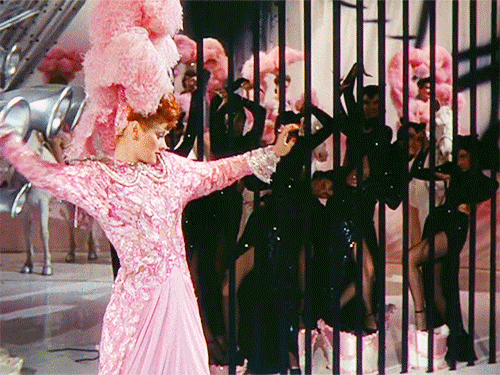
Dancers
Gloria Joy Arden
Jean Ashton
Irene Austin
Judi Blacque
Bonnie Barlowe
Norman Borine
Hazel Brooks
Ed Brown
Kathleen Cartmill
Jack Cavan
Marilyn Christine
Laura Corbay
Rita Dunn
Meredyth Durrell
Shawn Ferguson
Jeanne Francis
Jean French
Mary Jane French
David Gray
Bill Hawley
Doreen Hayward
Charlotte Hunter
Virginia Hunter
Patricia Jackson
Margaret Kays
Laura Knight
Laura Lane
Dale Lefler
Melvin Martin
Diane Meredith
Lorraine Miller
Joyce Murray
Janet Nevis
Ray Nyles
Billy O'Shay
Jane Ray
Dorothy Raye
Beth Renner
Melba Snowden
Walter Stane
Ivon Starr
Robert Trout
Chorus Boys
Rod Alexander
Milton Chisholm
Dick D'Arcy
Dante DiPaolo
Don Hulbert
Herb Lurie
Matt Mattox
Bert May - appeared on “The Lucy Show” in “Lucy and Tennessee Ernie Ford”
Jack Purcell
Tommy Rall
Ricky Ricardi (!)
Alex Romero
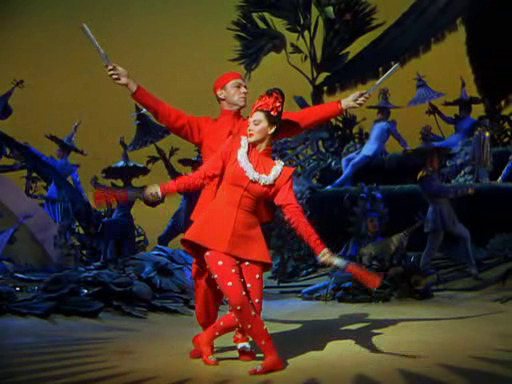
“LIMEHOUSE BLUES” starring Fred Astaire, Lucille Bremer, and Robert Lewis
Robert Ames (Masked Man)
James Barron (Couple with Banners)
Eleanor Bayley (Couple with Branches)
Mary Jo Ellis (Couple with Banners)
Sean Francis (Ensemble)
James King (Rooster)
Harriet Lee (Bar Singer)
Eugene Loring (Costermonger)
Charles Lunard (Masked Man)
Patricia Lynn (Ensemble)
Ruth Merman (Ensemble)
Garry Owen (1st Subway Policeman)
Ellen Ray (Couple with Parasols)
Jack Regas (Masked Man)
Billy Shead (Couple with Parasols)
Ronald Stanton (Couple with Branches)
Wanda Stevenson (Ensemble)
Ray Teal (2nd Subway Policeman)

“LOVE” starring Lena Horne
Juliette Ball (Club Patron)
Lennie Bluett (Dancer)
Suzette Harbin (Flirt)
Avanelle Harris (Club Patron)
Maggie Hathaway (Dancer)
Charles Hawkins (Club Patron)
Marie Bryant (Woman Getting Her Man Taken)
Cleo Herndon (Dancer)

“THIS HEART OF MINE” starring Fred Astaire and Lucille Bremer
Helen Boyce (Countess)
Feodor Chaliapin Jr. (Lieutenant)
Naomi Childers (Duchess)
Charles Coleman (Majordomo)
Sam Flint (Majordomo's Assistant)
Sidney Gordon (Masked Man)
Count Stefenelli (Count)
Robert Wayne (Dyseptic)

“PAY THE TWO DOLLARS” starring Edward Arnold and Victor Moore
William Bailey (Subway Passenger)
Joseph Crehan (1st Judge) - played a Detective on “I Love Lucy” “The Great Train Robbery”
William B. Davidson (2nd Judge)
Eddie Dunn (3rd Subway Policeman)
Harry Hayden (Warden)
George Hill (2nd Subway Policeman)
Wilbur Mack (Subway Passenger)
Larry Steers (Magistrate)
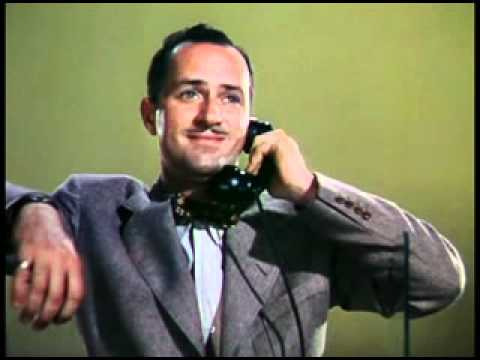
“NUMBER PLEASE” starring Keenan Wynn
Peter Lawford (Voice of Porky)
Grady Sutton (Texan)
Audrey Totter (Phone Operator Voice)
Kay Williams (Girl)
OTHERS
Bunin's Puppets
Elise Cavanna (Tall Woman)
Jack Deery (Man)
Rex Evans (Butler in "A Great Lady Has An Interview”)
Sam Garrett (Roping / Twirling Act)
Silver (Horse in "Here's to the Ladies')
Arthur Walsh (Telegraph Boy in "A Sweepstakes Ticket") - appeared on “I Love Lucy” in “Lucy Has Her Eyes Examined” (ILL S3;E11).
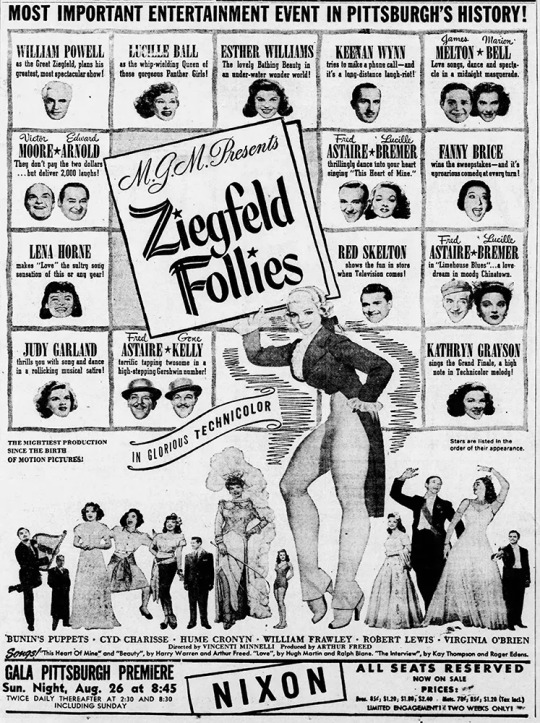
‘FOLLIES’ TRIVIA
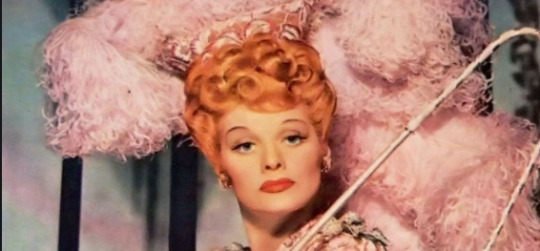
Sidney Guilaroff, Lucille Ball’s hair dresser, who takes responsibility for her famous ‘golden red’ for this movie, becoming her trademark color.
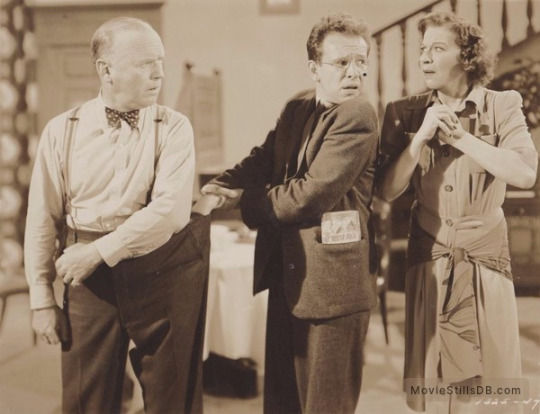
Although they appear in different segments, this is the only feature film collaboration between “I Love Lucy co-stars" Lucille Ball and William Frawley. Coincidently, Frawley's character in this film shares a striking similarity with his iconic character of Fred Mertz on “I Love Lucy.” In this film he plays a money-hungry curmudgeon of a landlord, much like the show. In the above photo, he appears with director Minnelli and co-star Brice.

The horse ridden by Lucille Ball is the Lone Ranger's Silver!
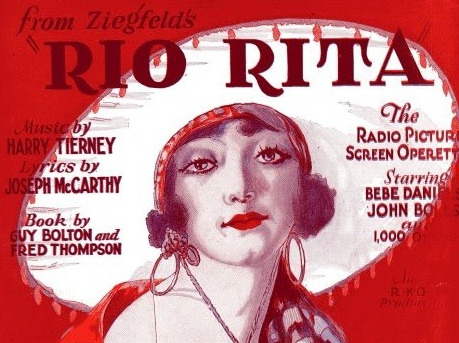
Lucille Ball was actually fired by Ziegfeld from his road company production of Rio Rita in the 1930s.

In February 1956, Lucy and Desi appeared on “MGM Parade” to promote their MGM film Forever Darling. The show also included footage of Lena Horne singing from Ziegfeld Follies.
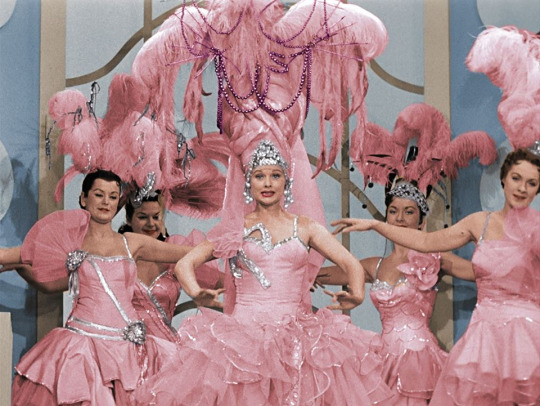
Lucy also played a showgirl in pink in “Lucy Gets Into Pictures” (ILL S4;E19) aired on February 21, 1955. The scene was inspired by Ziegfeld’s legendary stage shows featuring beautiful women wearing elaborate costumes navigating long staircases. To solidify the comparison, Ricky says he is going to a meeting with Mr. Minnelli. Vincente Minnelli was one of the directors of Ziegfeld Follies.

Lucy Ricardo had previously cavorted around in a lampshade in the manner of a Ziegfeld girl in both the unaired pilot and “The Audition” (S1;E6).
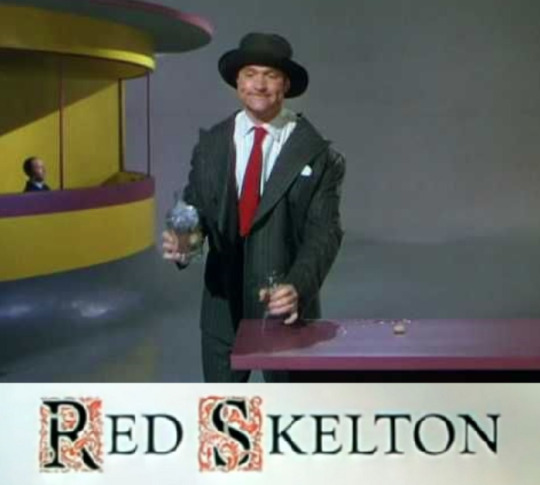
Ziegfeld Follies includes a sketch for Red Skelton called “When Television Comes” aka “Guzzler’s Gin” in which a (future) television spokesman gets increasingly sloshed on his product. This sketch was an obvious influence on Lucy’s Vitameatavegamin routine in “Lucy Does a TV Commercial” (ILL S1;E30) aired on May 5, 1952.

Ziegfeld Girl Eve Whitney appeared on “I Love Lucy” episode “The Charm School” (ILL S3;E15). She used her own name for the character.
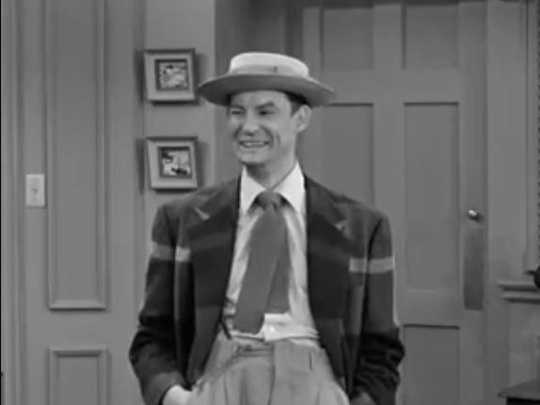
The Telegraph Boy in "A Sweepstakes Ticket" Arthur Walsh - appeared on “I Love Lucy” in “Lucy Has Her Eyes Examined” (ILL S3;E11) as Arthur ‘King Cat’ Walsh. He teaches Lucy how to jitterbug.
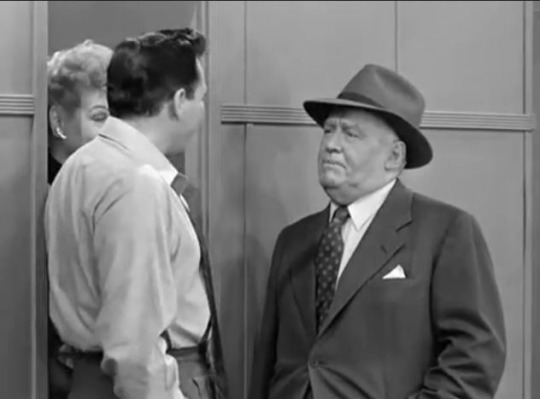
The first Judge in the “Pay the Two Dollars” James Crehan also played the Police Detective on “I Love Lucy in “The Great Train Robbery” (ILL S5;E5) first aired on October 31, 1955.

Porky, a voice on the telephone in “Number Please” Peter Lawford, played “Password” against Lucille Ball on September 24, 1964. At the time, Lawford was married to President Kennedy’s sister, Patricia. On November 26, 1968, Ball was a guest on “The Tonight Show” when Peter Lawford was sitting in for Johnny Carson.
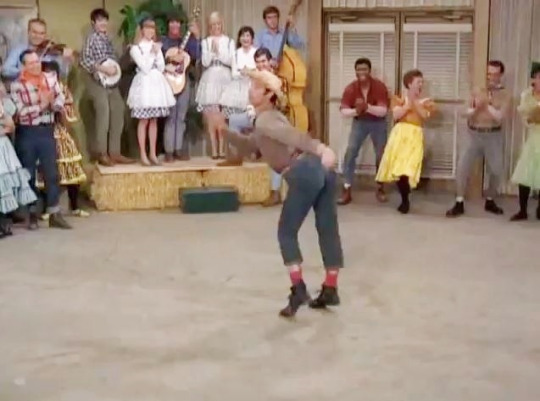
Chorus Boy Bert May appeared as a solo dancer on “The Lucy Show” in “Lucy and Tennessee Ernie Ford” (TLS S5;E21) in February 1967.

In the dressing room, Lucy jokes with Fanny Brice, one of the funniest women in showbusiness. This was the only time Ball and Brice collaborated and was Brice’s last film.

Ziegfeld’s follies began on Broadway, so it was appropriate that the show featured past and future Broadway musical stars:
Lucille Ball ~ Wildcat (1960)
Carol Haney ~ The Pajama Game (1954)
Tommy Rall ~ Call Me Madame (1950)
Fanny Brice ~ The Ziegfeld Follies
Marion Bell ~ Brigadoon (1947)
Victor Moore ~ Anything Goes (1934)
There was a lot of material that was not filmed, but written and cast. Some of the original skits would have added “Lucy” performers Mickey Rooney, Ann Sothern, and Van Johnson to the cast.
#Ziegfeld Follies#Lucille Ball#Florenz Ziegfeld#1946#MGM#Fanny Brice#Fred Astaire#William Frawley#Arthur Walsh#Eve Whitney#Bert May#peter lawford#James Crehan#I love lucy#Red Skelton#Keenan Wynn#Gene Kelly#Judy Garland#Esther Williams#Lucille Bremer#Lena Horne#Vincente Minnelli#William Powell#Cyd Charisse
61 notes
·
View notes
Text
The Academy Awards through the years: PT. 1
By Los Angeles Times Staff
Feb. 26th, 2017
The first ceremony made the Los Angeles Times’ front page under the headline “Film-Merit Trophies Awarded.” Coverage was all of one photograph and two paragraphs. Since then, the Academy Awards have become an event watched around the world. Scroll down for a year-by-year look at the Oscars.
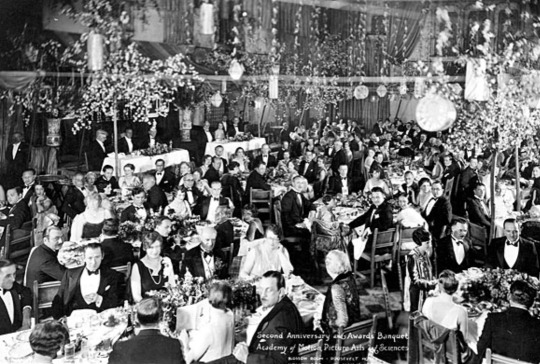
May 16, 1929. The first Academy Awards at the Hollywood Roosevelt's Blossom Room (Academy of Motion Picture Arts and Sciences)
Before a large gathering of motion-picture celebrities and other notables, the first Academy Awards ceremony is held at the Hollywood Roosevelt Hotel. Academy President Douglas Fairbanks handed out 15 statuettes for outstanding achievement in 1927 and 1928.
Best picture: “Wings”
Actor: Emil Jannings, “The Last Command” and “The Way of all Flesh”
Actress: Janet Gaynor, “Seventh Heaven,” “Street Angel” and “Sunrise”
Director: Frank Borzage, “Seventh Heaven”

April 3, 1930. "Broadway Melody" was released in 1929 and took top honors at the Academy Awards the next year. (MGM)
The Academy Awards are announced during a banquet attended by 300 academy members and their guests at the Ambassador Hotel. Academy President William C. deMille presents seven gold statuettes.
Best picture: “The Broadway Melody”
Actor: Warner Baxter, “In Old Arizona”
Actress: Mary Pickford, “Coquette”
Director: Frank Lloyd, “The Divine Lady”

Nov. 5, 1930. Norma Shearer with her statuette for "The Divorcee." (Associated Press)
Conrad Nagel, vice president of the Academy of Motion Picture Arts and Sciences, presents the statuettes at the third awards ceremony. The 600 attendees watch “Artistic and Otherwise,” a “sound recording film” by Thomas A. Edison on the industry’s progress in the last decade.
Best picture: “All Quiet on the Western Front”
Actor: George Arliss, “Disraeli”
Actress: Norma Shearer, “The Divorcee”
Director: Lewis Milestone, “All Quiet on the Western Front”

Nov. 10, 1931. Marie Dressler and Lionel Barrymore after their wins. (Associated Press)
The notables of Filmland gather at the Biltmore Hotel for the annual banquet. U.S. Vice President Charles Curtis tells the 2,000 gathered: “To my mind, the motion-picture industry is one of man’s greatest benefactors — it is great in size, in reputation and in worth.”
Best picture: “Cimarron”
Actor: Lionel Barrymore, “Free Soul”
Actress: Marie Dressler, “Min and Bill”
Director: Norman Taurog, “Skippy”
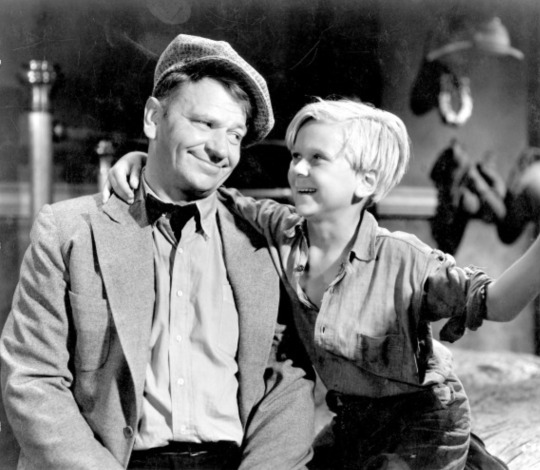
Nov. 18, 1932. Wallace Beery, left, and Jackie Cooper starred in "The Champ." (Academy of Motion Picture Arts and Sciences)
Lionel Barrymore is the toastmaster at the annual awards banquet at the Ambassador Hotel. Walt Disney is given a special award for his series of Mickey Mouse cartoons. As the ballots are turned in they are dropped into a special machine and tabulated “in full view of the assembled guests.”
Best picture: “Grand Hotel”
Actor: Fredric March, “Dr. Jekyll and Mr. Hyde” and Wallace Beery, “The Champ”
Actress: Helen Hayes, “The Sin of Madelon Claudet”
Director: Frank Borzage, “Bad Girl”

March 16, 1934. Douglas Fairbanks Jr. with Katharine Hepburn in a scene from "Morning Glory" (Associated Press)
Katharine Hepburn, still a newcomer to Hollywood, wins her first Academy Award for her work in “Morning Glory.” “Little Women,” in which she also stars, finishes third in the race for best production behind “A Farewell to Arms” and the winner, a film adaptation of playwright Noel Coward’s “Calvacade.”
Best picture: “Cavalcade”
Actor: Charles Laughton, “The Private Life of Henry VIII”
Actress: Katharine Hepburn, “Morning Glory”
Director: Frank Lloyd, “Cavalcade”
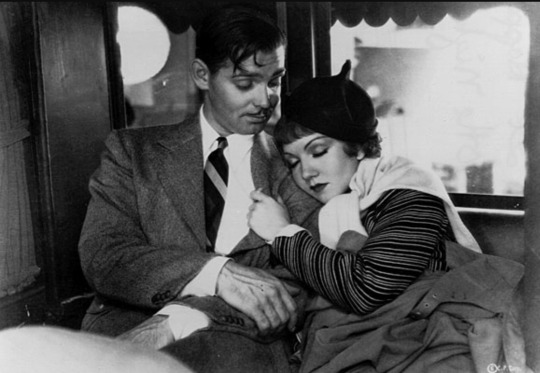
Feb. 27, 1935. Clark Gable and Claudette Colbert in "It Happened One Night." (Columbia Pictures)
The humorist Irvin S. Cobb presents the gold statuettes at the Biltmore Hotel. In “a radical departure from all previous elections,” the balloting is done in the open and write-ins are allowed. Although she doesn’t win, Bette Davis receives the most write-in votes for her work in “Of Human Bondage.”
Best picture: “It Happened One Night”
Actor: Clark Gable, “It Happened One Night”
Actress: Claudette Colbert, “It Happened One Night”
Director: Frank Capra, “It Happened One Night”
*Courtesy of Los Angeles Times.
#academy awards#old academy awards#vintage academy awards#old hollywood stars#old movies#old films#old hollywood#old cinema#vintagewomen#vintagephotos#vintagefashion#vintage hollywood#vintage films#vintage cinema#early academy awards#1920s#1920s hollywood#1920sfashion#1920s film#1920s history#1930smovies#1930sfashion#1930s hollywood#1930s#1930s cinema#1930s photography#los angeles times#clark gable#film-merit trophies awarded#hollywood roosevelt hotel
3 notes
·
View notes
Text
The Bakery 1921
Another comedy short turns 100 years old. This one by an almost forgotten comedian, Larry Semon. And playing the heavy in this film is Oliver Hardy. This is an above average sample of Larry Semons work. He construct some elaborate comedy situations and this one has a few solid laugh out loud moments.
youtube
0 notes
Text
Tuesday, November 10, 1931|Honoring movies released from August 1, 1930 - July 31, 1931
OUTSTANDING PRODUCTION
youtube
WINNER
CIMARRON
RKO Radio
NOMINEES
EAST LYNNE
Fox
THE FRONT PAGE
The Caddo Company
SKIPPY
Paramount Publix
TRADER HORN
Metro-Goldwyn-Mayer
DIRECTING
youtube
WINNER
SKIPPY
Norman Taurog
NOMINEES
CIMARRON
Wesley Ruggles
A FREE SOUL
Clarence Brown
THE FRONT PAGE
Lewis Milestone
MOROCCO
Josef Von Sternberg
CINEMATOGRAPHY
youtube
WINNER
TABU
Floyd Crosby
NOMINEES
CIMARRON
Edward Cronjager
MOROCCO
Lee Garmes
THE RIGHT TO LOVE
Charles Lang
SVENGALI
Barney "Chick" McGill
ACTOR

WINNER
LIONEL BARRYMORE
A Free Soul
NOMINEES
JACKIE COOPER
Skippy
RICHARD DIX
Cimarron
FREDRIC MARCH
The Royal Family of Broadway
ADOLPHE MENJOU
The Front Page
ACTRESS

WINNER
MARIE DRESSLER
Min and Bill
NOMINEES
MARLENE DIETRICH
Morocco
IRENE DUNNE
Cimarron
ANN HARDING
Holiday
NORMA SHEARER
A Free Soul
ART DIRECTION
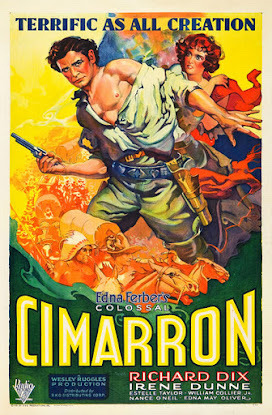
WINNER
CIMARRON
Cimarron
NOMINEES
JUST IMAGINE
Stephen Goosson, Ralph Hammeras
MOROCCO
Hans Dreier
SVENGALI
Anton Grot
WHOOPEE!
Richard Day
WRITING (ORIGINAL STORY)

WINNER
THE DAWN PATROL
John Monk Saunders
NOMINEES
THE DOORWAY TO HELL
Rowland Brown
LAUGHTER
Harry d'Abbadie d'Arrast, Douglas Doty, Donald Ogden Stewart
THE PUBLIC ENEMY
John Bright, Kubec Glasmon
SMART MONEY
Lucien Hubbard, Joseph Jackson
WRITING (ADAPTATION)

WINNER
CIMARRON
Howard Estabrook
NOMINEES
THE CRIMINAL CODE
Seton I. Miller, Fred Niblo, Jr.
HOLIDAY
Horace Jackson
LITTLE CAESAR
Francis Faragoh, Robert N. Lee
SKIPPY
Joseph L. Mankiewicz, Sam Mintz
0 notes
Text
Only a handful of movies have been announced for the 2018 Turner Classic Movies Film Festival (TCMFF), but excitement builds anyway as tickets are scheduled to go on sale in just a few days. The 2018 festival is scheduled for April 26 – 29 and many of us have been waiting for 2018 passes since this year’s event concluded. It’s a vicious cycle we enjoy perpetuating. In any case, mark your calendars for 10AM ET. on Tuesday, November 7 if you’re a Citi member for the exclusive pre sale and for 10AM ET. November 9 for the public sale. Get all of the details you need at TCM. You’ll note, by the way, that passes for this festival are not cheap and overall expenses can be prohibitive, but if you’re a classics fan and have never attended TCMFF it’s a sacrifice worth making at least once. You can read any number of posts about past experiences by many bloggers to know why. Now to 2018…
Along with the anticipation of the festival itself is the yearning for our favorite movies to be screened. I’ve yet to be disappointed with a screening in the five years I’ve attended the festival, but that doesn’t mean I don’t have ideas about what I would love to see. This year is no different. The chosen theme for TCMFF 2018 is Powerful Words: The Page Onscreen, which is intended as a “celebrating the representation of the written word on the silver screen.” When you consider that all movies start out as written words the possibilities for screenings are endless. That said, I still have had specific titles swirling around in my head since the dates and theme were announced and I’d like to share those recommendations with you. I should mention that I planned the list to contain 10 suggestions, but as you’ll see I failed miserably at limiting the list to so few. In fact, it was a strain on my heart to keep it at a svelte 21.
These are not listed in order of preference and I also did not take into account whether any have been screened in previous festivals. I don’t think that should necessarily be a deterrent. You’ll also notice my choices are from varied eras, allowing for the greatest number of guests possible. I’ve highlighted the guests I’d like to see in a few instances to make it easy for TCM to know who they should extend an invitation to. You’re welcome! Also, while I don’t mention the inclusion of writers they would no doubt enhance any presentation. Here we go…
My TCMFF 2018 Recommendations
Powerful Words: The Page Onscreen
Alan Crosland’s The Beloved Rogue (1927) starring John Barrymore and Conrad Veidt gets the most votes in my mind. This film, about French poet François Villon, had been thought lost for decades. According to legend, The Beloved Rogue is the John Barrymore movie the star watched with a large audience who didn’t know he was in attendance. The story goes that Barrymore was standing at the back of the movie palace and, dissatisfied with his own performance, said, “what a ham…”
It would be fun to have Drew Barrymore introduce this movie with Tom Meyers of the Fort Lee Film Commission. Tom and his team have several Barrymore-related projects in the works in Fort Lee. The Barrymores have strong ties to America’s first film town. I believe the TCMFF crowd would appreciate some early film history added to the introduction of the great Barrymore in a silent movie.
Another movie I am really rooting for is William Dieterle‘s The Life of Emile Zola (1937). This movie has a memorable supporting cast, but it’s the film’s star, Paul Muni, who would make this special. He was my father’s favorite actor, which means a lot to me right now. Plus I’ve never seen him on a big screen. This biopic of the famous French novelist, which won Best Picture of the year, would be the perfect opportunity for me to do so.
Rouben Mamoulian‘s 1931 screen adaptation of Robert Louis Stevenson‘s Strange Case of Dr. Jekyll and Mr. Hyde is another one I’d love to see. Dr. Jekyll and Mr. Hyde stars Fredric March, who won the Oscar for his portrayal of the main character(s), and Miriam Hopkins who is always enjoyable to watch.
Curtis Bernhardt‘s Devotion (1946) starring Ida Lupino and Olivia de Havilland as Emily and Charlotte Bronte should be a strong contender. The movie also stars Paul Henreid, which means Monika Henreid can be on hand to introduce the movie. Monika has just completed Paul Henreid: Beyond Victor Laszlo, a documentary focused on her father’s career.
Based on John Steinbeck‘s Pulitzer Prize winning novel, John Ford‘s The Grapes of Wrath (1940) is as essential as it gets among book-to-film adaptations. It would be terrific to have both Jane Fonda and Peter Fonda on hand to introduce this movie, which features one of the greatest performances from their father’s legendary career.
Based on a collection of stories titled The Jungle Book by Rudyard Kipling (1894), Disney’s 1967 animated classic of the same name directed by Wolfgang Reitherman should be considered a bare necessity. (Pa rum pum.) But seriously folks, wouldn’t it be fun to watch this animated classic together?
Norman Taurog‘s The Adventures of Tom Sawyer (1938) would be an enjoyable screening. This movie features a stellar cast and we can have the added attraction of Cora Sue Collins in attendance to discuss the making of it. Cora Sue plays Amy Lawrence in the movie and she is sure to enchant the TCMFF crowd with her stories.
The perfect vehicle to follow Tom Sawyer is Irving Rapper‘s The Adventures of Mark Twain (1944). This movie is not without its flaws, but it’s no throw away second feature either. After all Twain, born Samuel Langhorne Clemens, was one of – if not thee – greatest humorists the world has ever known. His story deserves the kind of actors cast in this picture including Fredric March, Alexis Smith, Donald Crisp and Alan Hale leading a terrific list of supporting players. To introduce this one we can have any number of Mark Twain Prize winners including Carol Burnett, Carl Reiner, Billy Crystal, Tina Fey, Bill Murray, Eddie Murphy, Whoopi Goldberg and on and on. Just sayin’.
Sidney Franklin‘s The Barretts of Wimpole Street (1934) starring Norma Shearer and Fredric March focuses on the difficult early family life of poet Elizabeth Barrett Browning. This is another one I’d love to see with the TCMFF audience. The cast alone is worth standing on line for.
The lovely Barbara Rush should introduce The Young Philadelphians (1959) in which she co-starred with Paul Newman. Directed by Vincent Sherman, the movie is based on a 1956 novel by Richard Powell. Plus, I happen to be very fond of it and its terrific cast, which includes Alexis Smith, Brian Keith, Robert Vaughn, Billie Burke and a few other classic greats of note. I’d have Illeana Douglas interview Barbara Rush, by the way.
Rob Reiner’s Misery (1990) is memorable thanks in large part to Kathy Bates’ extraordinary performance as the fan from hell. The fact that the movie is sure to chill even the most ardent horror fan is a side benefit. With Reiner, Bates and James Caan, (who’s also great in the movie) in attendance the experience would be absolutely unforgettable. Jot that down!
Based on the novel Wuthering Heights by Emily Brontë (1847), William Wyler’s 1939 movie of the same title would be a treat on the big screen. I have to admit I’m not a huge fan of this movie because of what I think is a sell out ending. However, I also think it would be an immersive experience watching Wuthering Heights with a TCMFF audience.
Lumet’s criminally underrated Fail-Safe (1964) starring Henry Fonda, Walter Matthau and another impressive list of players is one of the greatest thrillers of all time. Directed in the style of 12 Angry Men, Fail-Safe is based on the novel by Eugene Burdick. With an ending that leaves one speechless this is sure to be a hit with the TCMFF crowd. Again, the Fondas could introduce it along with Charles Matthau.
Phil Karlson’s Scandal Sheet (1952) starring Broderick Crawford and Donna Reed is a fantastic film noir choice. I know Reed’s daughter, Mary Owen, does appearances for screenings of her mother’s films. It would be great to have her introduce this movie, which tells the story of a newspaper editor who commits a murder, alongside Eddie Muller.
George Cukor’s version of Louisa May Alcott’s novel would be fantastic to see on the big screen. Little Women (1933) features an impressive cast any number of which can be well represented for an introduction. To name just two ideas – Tom Meyers would do a swell job of representing the Fort Lee-born Joan Bennett and Wyatt McCrea can discuss the movie and Frances Dee’s career.
Fred Zinnemann’s Julia (1977) is based on the story by Lillian Hellman and both of the film’s two stars, Jane Fonda and Vanessa Redgrave, deliver affecting performances. It would be a huge attraction to have them both in attendance for a screening of this memorable film.
Peter Brook’s 1963 adaptation of William Golding’s Lord of the Flies is a must. I had to read the book in high school and I will never forget the effect it had on me. The same goes for Brook’s naturalistic and truthful telling of the disturbing story. Any member of the cast and/or the director in attendance to discuss the making of the movie would be great.
Charles Vidor’s Hans Christian Andersen (1952) starring Danny Kaye is my favorite of his movies. Beautiful to look at, wonderful to listen to and with all the charm of its star, Hans Christian Andersen reminds us fairy tales can come true. Who doesn’t want to share that with like-minded classic movie fans?
An Odets/Lehman screenplay based on a Ernest Lehman novel – that’s what big money screenings are made of. Oh yeah plus Lancaster, Curtis and a memorable supporting cast. That’s what makes up Alexander Mackendrick‘s Sweet Smell of Success (1957) and its cynical world. I would love to see this introduced by Jamie Lee Curtis and Eddie Muller.
Any number of movies based on the writing of W. Somerset Maugham would be treats at TCMFF. For personal reasons, however, I’m going with William Wyler’s The Letter (1940), which is based on a 1927 play by Maugham. Given this movie’s power of seduction (who can look away after that opening sequence) it deserves an introduction with serious clout. My plan would be to ask either Susan Sarandon, since she narrates the TCM original documentary, Stardust: The Bette Davis Story, or Meryl Streep who narrates the terrific Tribute to Bette Davis on the network. Both of them in attendance talking about Davis before we watch one of her greatest films would be a dream.
I was going to end my recommendations list with Wilder’s Sunset Blvd. because what better example of writing for the screen is there? But then I couldn’t in good conscience include Wilder’s masterpiece and leave out the movie that beat it at the Oscars, Joseph L. Mankiewicz’s All About Eve (1950), which I also love. Of the two I had to admit Mankiewicz’s movie is the better choice due to the fact that the writer of the short story, The Wisdom of Eve, on which the movie is based does not get screen credit. TCMFF 2018 is the perfect occasion during which to honor the writer’s work officially this many years later. Of course either Sarandon or Streep would do quite nicely introducing this movie alongside Ben Mankiewicz.
Mary Orr’s The Wisdom of Eve was originally a 9-page short story that appeared in Cosmopolitan magazine in May 1946. Orr later expanded the story, in collaboration with Reginald Denham, into a successful play. 20th Century Fox later paid Mary Orr $5,000 for all rights to The Wisdom of Eve. What resulted is one of the all-time great motion pictures, which also deals with the importance of writing to a star’s career – stage or screen.
Those are my 21 choices. I know acquiring all of the movies I mentioned is not possible and I know that some may not even be in good shape, but maybe I made note of a few that hadn’t occurred to anyone before. If not, then at least I enjoyed giving serious thought to how I would schedule the festival myself if I had great powers. Also, in case anyone’s interested, I have quite a few ideas for panels and Club TCM presentations. For instance, Illeana Douglas can moderate a group discussion about Pioneering Women Screenwriters and Victoria Riskin can discuss her father Robert Riskin’s many contributions to films. Let me know if you want to hear more of those ideas and what your movie recommendations would be. Here endeth my post.
Hope to see you at TCMFF 2018!
The Page Onscreen: Recommendations for #TCMFF 2018 Only a handful of movies have been announced for the 2018 Turner Classic Movies Film Festival (TCMFF)
4 notes
·
View notes
Text
New Post has been published on Cinephiled
New Post has been published on http://www.cinephiled.com/city-los-angeles-proclaims-celebration-virginia-weidler/
City of Los Angeles Proclaims ‘A Celebration of Virginia Weidler’
When screen legend John Barrymore declares a 12-year-old girl he worked with as “Hollywood’s greatest actress,” you can’t help but take notice. Born 90 years ago today, classic movie fans remember Virginia Weidler as Dinah Lord, Katharine Hepburn’s precocious sister in MGM’s The Philadelphia Story. She was the girl who played “Lydia the Tattooed Lady” for a bewildered Jimmy Stewart and Ruth Hussey and who did everything she could to sabotage Hepburn’s impending nuptials to George Kittredge. Young Weidler was brilliant in the film, and that performance, along with her role as Little Mary, Norma Shearer’s daughter in MGM’s all-star, all-female The Women, is what she is most known for today. Many people are not familiar with her remarkable career before these two films. Virginia Weidler made over 40 films in her relatively short career and had very successful stints at Paramount, RKO, and other studios. She was still a teenager when she made her final film in 1943. She continued to appear on the stage for several years and in 1947 married naval officer Lionel Krisel and raised two boys, Ron and Gary, before she died in 1968.
For several years, I’ve been involved with an online group to honor the work of the brilliant child star. Founded by Baltimore-based Pete White, The Virginia Weidler Remembrance Society has researched every aspect of Weidler’s career, her films, and her contemporaries, and in 2014 successfully lobbied Turner Classic Movies several for a six-film tribute called “Starring Virginia Weidler.” This year, to mark the 90th anniversary of Weidler’s birth, White contacted the Los Angeles City Council (including councilperson José Huizar who represents Weidler’s Eagle Rock birthplace) to honor the hometown girl. They agreed about Weidler’s contributions, and issued a beautiful proclamation signed by every member of the City Council that details Virginia’s achievements and concludes with the following:
NOW, THEREFORE BE IT RESOLVED, that by the adoption of this resolution, the City Council of Los Angeles recognizes VIRGINIA WEIDLER for her career accomplishments as well as her contributions to her country, her city, and to all who knew her and that March 21, 2017 is a celebration of Virginia Weidler.
I had the great pleasure of presenting this proclamation to Virginia Weidler’s granddaughter, Lindsay Rock Krisel. “All of us in the family are absolutely thrilled that Ginny’s work is still remembered and celebrated,” Lindsay said upon receiving the resolution. “She was born into a creative, expressive, weird, wonderful family who came to Los Angeles in the 1920s, drawn to America partly because of their reverence for Walt Whitman. She was an incredibly devoted mother — my dad says it was like growing up in a musical. I never got to meet her, and it’s an odd thing that when asked to imagine my grandmother, I usually picture her as a child. But even in her most famously precocious moments on film, she always maintained an honesty about childhood — a curious, mischievous, authentic energy. It is a privilege to be in her family, and a privilege to live in a place that cherishes its memories, and the accomplishments of its young citizens.”
As Lindsay said, Ginny (as she was known by her family and friends), was born into a showbiz family of immigrants in Eagle Rock, California, on March 21, 1927. Her parents, former opera singer Margaret Weidler and architect Alfred Weidler, had children: Sylvia, Renee, Warner, Walter, George, and Virginia. While the three Weidler boys appeared in several films together, including Shirley Temple’s Dimples, and had long careers as successful musicians, it soon became clear that Virginia was the standout actress in the family.
Weidler’s first credited role in the movies was as Europena Wiggs in Norman Taurog’s Mrs. Wiggs of the Cabbage Patch (1934) starring Pauline Lord, W.C. Fields, Zasu Pitts. Ginny went over big and, with Paramount looking to get in on the boom started by Shirley Temple at 20th Century Fox, several more projects were planned for the young girl. She was also loaned out to RKO and other studios and quickly gained a reputation for being one of the most reliable and skilled actresses around who could hold her own with all of the great stars of the day.
Weidler consistently received raves for her acting. She was a sensation as Little Sister in her next film, George Stevens’ poignant Laddie (1935) with John Beal and Gloria Stuart, and made many other films, some of them true starring vehicles. Virginia’s movies during the 1930s included Freckles (1935), Girl of the Ozarks (1936), The Outcasts of Poker Flat (1937), Love Is a Headache (1938), and Bad Little Angel (1939). She worked with many of the top stars in Hollywood and received praise from all quarters. In 1939, Ginny co-starred with John Barrymore in Garson Kanin’s The Great Man Votes in 1939. That’s when Barrymore, impressed by Weidler’s incredible talent at such a young age, first gave her that nickname, a claim he repeated the following year when he visited his friend and former co-star Katharine Hepburn on the set of The Philadelphia Story. “I’m thrilled to be seeing Hollywood’s greatest actress in action again,” Barrymore told Hepburn after watching the cast shoot a pivotal scene. “Oh, thank you, John,” Hepburn replied. “No, Kate, I was talking about Virginia Weidler!” Hepburn laughed, and didn’t take offense. She knew they were lucky to have Virginia in the film.
Weidler’s films continued into the early 1940s. In addition to her important role in The Philadelphia Story and her appearance in The Women, Virginia played one of Charles Boyer’s daughters in All This, and Heaven Too (1940) with Bette Davis; sang and danced alongside Mickey Rooney and Judy Garland in the Busby Berkeley musical Babes on Broadway (1941), and starred in the Technicolor extravaganza Best Foot Forward (1943) and The Youngest Profession (1943) which turned out to be her last two films.
I had the pleasure of talking to the late Robert Osborne about Weidler on several occasions. He was a huge fan of her work and told me how his mentor in Hollywood, Lucille Ball, loved Virginia (they worked together on Best Foot Forward). When I got the chance to talk to Jane Withers at the TCM Classic Film Festival in Hollywood, she became teary-eyed when discussing her old friend. Pete White has also spoken to some of Ginny’s friends and colleagues and was impressed by what they had to say about her. “Not one person has ever said a single unkind thing about Virginia Weidler. Even those she only touched professionally all remark on her kindness, helpfulness, and professionalism. Tommy Dix (Weidler’s love interest in Best Foot Forward) brought me to tears last year with the things he had to say about her and he only knew her during the making of that film over 70 years ago! Former actor and M*A*S*H producer Gene Reynolds knew her for many years and felt the same tender way toward her. All of these people whose lives were touched by Virginia seem to agree with what actress actress Jean Porter wrote years ago — that Virginia was the nicest person they ever met.”
Although there are very few public photos of Virginia Weidler once she left the movie industry, her granddaughter shared this priceless photo taken of Virginia during the time she and her husband were living in Cuba in the 1950s when they would often visit the home of Ernest Hemingway. That’s Ginny and her husband, Lionel Krisel, looking at the camera, Ernest and Mary Hemingway looking at Ginny, and a couple who won a trip to visit the legendary author in a game show with the final answer “Ernest Hemingway.” Lindsay also shared that when the Duke of Windsor would visit the Hemingways he would specifically seek out Ginny as a dance partner!
While some of Weidler’s bigger films are screened regularly on TCM, click here for a very special birthday treat — you will find links to several early films of Ginny’s that are hard to find. You’ll also find the full text of her friend Jean Porter’s poignant and heartfelt tribute to the actress. Finally, check out the great clip below from The Philadelphia Story that is one of my favorite scenes ever in which Dinah Lord, in cahoots with her sister Tracy (Katharine Hepburn), puts on quite a show for a reporter (James Stewart) and photographer (Ruth Hussey) who are trying to crash Tracy’s wedding.
youtube
0 notes
Text
The Rent Collector (1921)
Another obscure silent comedy turned 100 years old. Larry Semon was a very popular comedian in his day. His films are filled with elaborate site gags, that started costing more and more to make. He hit financial disaster when he produced his 1925 version of The Wizard of Oz. That was the end of his film career. He went back to Vaudeville and soon after had a nervous breakdown. He died of pneumonia and TB at the age of 39. Today he is mostly remembered because many of his films co-starred Stan Laurel and Babe Hardy (never together) before they became Laurel and Hardy.
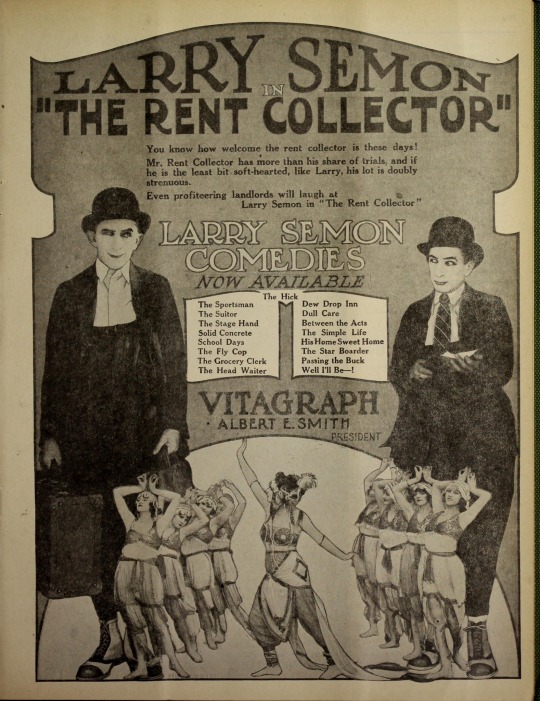
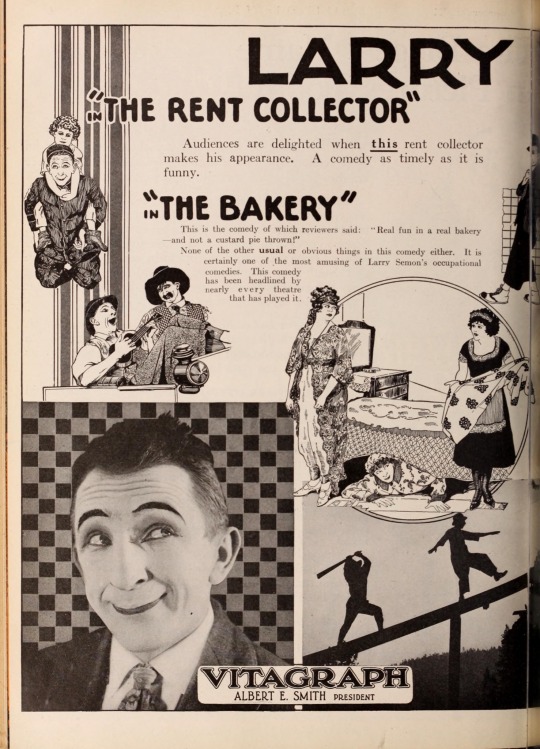
1 note
·
View note